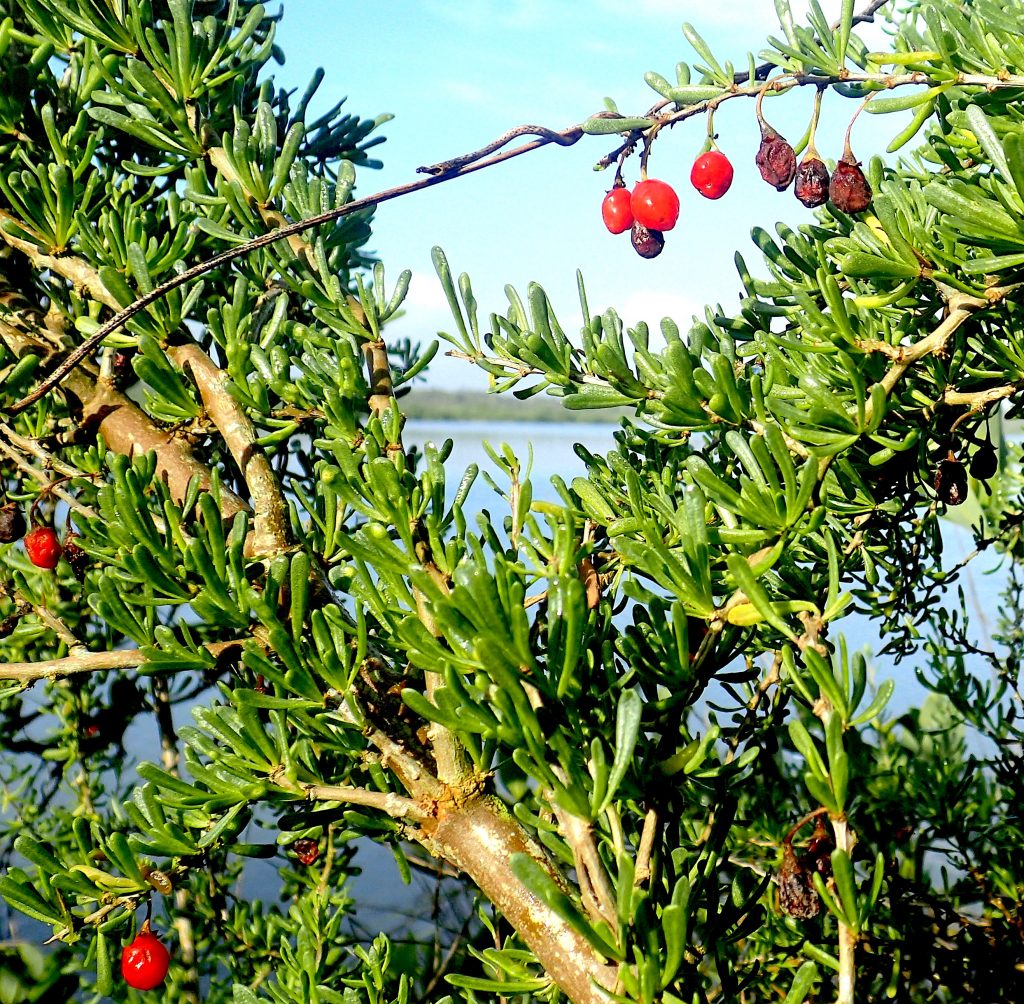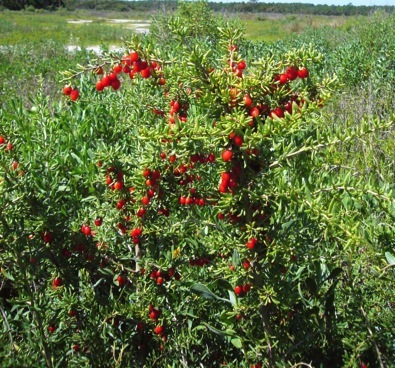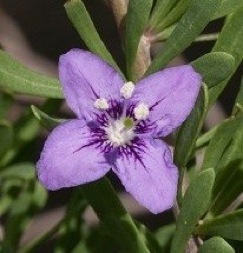
Photo by Green Deane
Christmas, Wolf, Goji, They’re All Berries
It’s called the Christmasberry even though it fruits from Christmas to April. And while it is one of several “Christmas Berries” this one happens to have a famous relative, the Goji berry of health food fame.
Botanically the Christmasberry is Lycium carolinianum (not to be confused with a couple of edible Crossopetalums also called Christmas Berry.) As for how Lycium carolinianum is pronounced is a bit of debate. Some say LIE-see-um, others lie-SEE-um. As the original word is from the Greek, λύκειον (LEE-kee-on) meaning a Greek school we might argue the genus is more properly LEE-see-um. Carolinianum means central North America and is said kar-row-linn-ee-AY-num.
For most of the year the Christmasberry is an unimpressive shrub that resembles from a distance a rosemary bush. But there are hints of more going on. Its leaves are plump and the shrub is salt tolerant, preferring coastal or inland areas of high saline content. In early winter or late spring the fruit is quite attractive and a welcomed food for woodland creatures particularly birds. Technically the L. carolinianum fruits all year in Florida but favors the late fall and to early spring. However, I have also found them in abundance in mid-spring and late fall.
While the foliage would not give it away as a member of the Solanaceae clan the blossoms and berries can. The blossoms look very similar to other Solanums and the berries have an ornamental pepper look, if not in color then shape. The seeds are a familiar look as well reminding one of small tomatoes or pepper seeds. Opinions on taste vary, from sweet and tomato-ish to famine food. All the ones I’ve eaten were on the sweet and juicy side, soft if not hollow but there is a bit of aromatic oil or flavor to them as well as well, nothing dramatic but definitely there.
While most foraging books ignore the L. carolinianum in their line up of edible Lyciums Dr. Fernando Chiang of the National University of Mexico confirms academically that the fruit is edible. Dr. Chiang is an expert on the genus and was consulted on the species for the publication of Florida Ethnobotany by Dr. Daniel Austin. Chiang describes the berries of other Lyciums as “often edible.” At least one, L. acnistoides, found in Cuba, is toxic. In some species the berries and the leaves (cooked) are eaten. With some edible, one toxic for certain, and others unreported it is best to identify carefully.
In North America among the edibles species, besides L. carolinianum, L. andeersonii, L. fremontii, L. pallidum, and L. torreyi. The leaves of the L. halimifolium are cooked and eaten in Eurasia as is the L. chinense. Best known, perhaps, is a Lycium closely related to the L. chinense, and that is the L. barbarum, also called the Goji (GO-gee) berry which oddly is naturalized in England. Also listed as edible is Lycium ferocissimum, which is a pest in Australia. Its native L. australe was eaten by the Aboriginals.
Also called the Wolfberry, L. barbarum is known as a powerful antioxidant and credited with giving you energy, in and out of bed, better metabolism, improved immune system response, blood pressure regulation, cardiovascular health and slowing down aging. Animal research suggest it may be effective against cancer, inflammatory diseases, macular degeneration and glaucoma. It is consumed in the form of pills, juice, dried fruit, powder, teas and the seeds eaten.
The Goji berry is about 68% carbs, 12% proteins, 10% each of fiber and fat. A 100-gram serving is about 370 calories. It has 11 essential dietary minerals and traces of 22 others; 18 amino acids, six essential vitamins, five unsaturated fats, and five carotenoids. Specifically it is high in calcium, potassium, iron, zinc, selenium, vitamin B2, Beta-carotene, and exceptionally high amounts of vitamin C. It’s also full of antioxidants via its pigment, which I would presume to be lycopene. If your local Lycium lives up to that, it would be quite a dietary addition.
Processed fruits of various species in the genus have also been used to treat diabetes, impotence, and to retard aging. One ingredient, Physalin, is extracted to treat Hepatitis B. Another chemical, Betaine, is taken by weightlifters to bulk up.
As a food Goji berrie (L. barbarum) are usually bought dried like raisins and are cooked before eaten. But the berries are also used to make a tea. Young Goji shoots and leaves are used as a cooked green. The one medical warning associated with Goji berries is they may increase the potency of drugs like Warfarin (making you bleed more easily.) Goji berries also contain atropine in low amounts.
Clearly you cannot assume your local Lycium is as all-around edible as the Goji is. But, identify and investigate. One would presume many of them would have similar nutritional profiles.
And one last thing: Goji berries are very high in lectins. If those bother you then perhaps you should try only a few at first or skip them altogether.
Green Deane’s “Itemized” Plant Profile
IDENTIFICATION:
Lycium carolinianum: Shrub to six feet, sprawling, spiny, small, succulent leaves. The four-petaled, somewhat tubular, lavender/blue flowers usually singular, red/orange berries, fleshy. Locally they are often covered with Ramalina, a hairy lichen.
TIME OF YEAR:
Fruits year around in Florida but favors mid-spring
ENVIRONMENT:
Salt tolerant, coastal areas or inland salty ground
METHOD OF PREPARATION:
Ripe berries, fresh or dried, as fruit or tea. I eat them off the bush.




I learned about this from Green Deane in a class in Aug 2011 at Spruce Creek park, but it was just an unimpressive bush with no fruit. It is now December and there are berries on the bush. I ate a bunch of them and really like them. It tastes like tomato/pepper/sugar mixed together.
Where exactly does the lycium plant grow throughout the Americas? I live in Michigan near Detroit…
According to (banned site) the specific variety he’s showing grows down south. The other varieties he mentioned grow out west in deserts. So there’s no native wolfberries to Northern USA, but the Chinese wolfberries (goji berries) do well up north if you plant some yourself.
Anyway, I’m totally fascinated that America has it’s own goji berries. One day someone will get smart and dry these up and start selling them, just as was done with American ginseng/etc. It might even be “stronger” in Chinese medicine properties, the American “gojis.”
Sweet find. Wish we had them up here. Guess I’ll plant some Chinese ones in my yard…
I live in Sedona, AZ and am interested in foraging the wolfberry goji — any one out there give me an idea where to go? When I first got here this past Sept and was hiking on Airport Loop I found a bush that I just had an idea that was what it was — they were pretty small and round and bit larger than capers. I ate one the first passing then a couple and no side effects so I had a dozen or so and never had any side effects — the bush had rather stiff small leaves ………… anyone would love to find where they can be foraged here in AZ
On my home page under “foraging” there is a drop down menu of foraging instructors. Email some of those in Arizona. They can probably help.
I couldn’t find the “drop down menu of foraging instructors” that you said was under foraging on your homepage. I was particularly interested in those from Az.
The drop down menu is there and it is working. Move your cursor about a quarter of an inch below the “foraging” button.
Hi Deane
the Lycium ferocissimum that you list as a pest in Australia is native to South Africa where we know it as ‘snake berry’. It’s traditionally been eaten by San tribes centuries ago.
Here in California, Christmasberry is our local Toyon, once called Hollywood berry, it is why Hollywood (the city) is called that, Toyons graced the hills above the city in great numbers. Those hills are called the Hollywood Hills to this day
DANGER!!!!!!! WARNING!!!!! ATTENTION!!!!
Lycium spp Lycium Fremontii
After spending moths researching the edibility of these berries and even slow sampling of them one or two RIPE berries at a time and having no side effects over many weeks everything changed for me yesterday. Every website out there says they are safe well I decided to try eating 5 fresh ones. There is no mistaking the identity of these bushes or these berries. After I ate 5 I felt euphoric something that did not occur before when eating two or three and realized why they are considered a medicinal plant, I generally felt quite good. Then 12 hours later (the time it takes DEADLY SOLANINE to absorb through your digestive tract) I began feeling impending DOOM and anxiety, vision blurring, difficulty walking, strange delerium, etc. I tried to tough it out thinking hey I only ate 5 berries……. That tune quickly changed when symptoms began getting SCARY and I rushed to the ER. After hours of feeling dizzy and nauseus and outright horrible I was able to go home. DO NOT EAT THESE BERRIES!!!!!!!!!!!!!!!!!!!!! Anyone who has wrote anything on these berries does not have sufficient information regarding their toxicity. THEY ARE NOT SAFE!!!!!!!! These are nightshade family and are toxic!!!!!!!!! I have been the guinea pig for everyone to know that these berries are DANGEROUS!!!!!!! They may be medicinal but any medicinal part is useless when you also receiving DEADLY POISON!!!!!!!! I can absolutely see the proper chemists removing the SOLANINE poison and making some safe product out of this plant species but until then DO NOT EAT THESE BERRRIES!!!!!
Note you are referring to Lycium Fremontii and most of my article was about L. carolinianum. L.Fremontii is listed as an edible (in published works) but I do not have personal experience with it. I have eaten L. carolinianum with no problem. Thanks for telling us about your experience.
I disagree, you re-evaluate what u ate and repost. These berries are normally used in teas fresh in salads and China is still alive, review matrimony vine or wolf berrie for more info.
A weed growing in my yard was recognized by a Chinese lady as being closely related to the Goji, but she could not tell me an English name for it (and I didn’t catch the chinese name). This thing grows LONG shoots — 18 feet and more, usually not with many leaves on them. They do have widely-spaced thorns. I’ve never seen any fruits on it… just these long, long branches with very few side-branches.
Anyway this Chinese lady told me that in China they pick the leaves off this plant and cook them as a soup herb. She described its growth habit accurately and I have no reason to disbelieve this information I just wish it were more complete.
So, does anyone know the name of a plant closely related to Goji, and of which leaves may or may not be edible by everyone? I am concerned about eating foliage of any plant in the solanaceae family.
This weedy Goji-cousin has soft-woody root/runners that snake off in all directions underground. Because they are tangled in with an oak tree’s roots, I will not be able to dig it out altogether.
So what experience does anyone have with this plant? And does anyone know its name (botanical and/or popular)?
Lyciums are notoriously difficult to tell apart, and photos we take of the 4 native (Israel) species are a source of endless arguing in our facebook botanical forum.
Our local species never belie the Biblical allegory (Samuel B) regarding “Atad” not being good for much anything except the monarchy of trees, and noshing on one ripe fruit per foray is generally considered success.
There is one exception though: apart from the thornless Goji which few people grow successfully, and I’m not one of them, there exists a colony of an unidentified species in a park in old Jaffa, which bear large quantities of very tasty berries. Since this looks very much like the photos in the above article, a long-term mystery we’ve been scratching our heads about for ages might be close to a solution…
There were also a couple of pictures in my newsletter a couple of weeks back.
Link?
Everything on this website can be accessed via the search window, or clicking on Archive (which lists everything on the site alphabetically including newsletters. I also limit self linking because it make Google mad.) It was Dec 29: https://www.eattheweeds.com/newsletter-29-december-2015/
Thanx.
What type of plant do you think is most likely to be found in Canada with similar types of berries? There are some growing nearby with berries that are similar, but they are not sweet.
A number of Viburnums are in our area including V. trilobum and V. edule.
There is no mistaken identity going on here. Nothing needs to be re-evaluated, there’s no solid data on these things anywhere. The only data is on a famous (most likely domesticated) CHINESE variety from another continent.
The ones that I ate were picked in Sedona Arizona and occur all over wildly throughout the whole region. They grow in abundance around old native american ruins as they were used by those old cultures in some fashion.
Chinese Goji berries are different and are most likely domesticated with a trait preference of reduced solanum toxins. You can read about people over dosing on Goji berries online and being rushed to the ER. However they consumed very large amounts of them for that to happen.
I don’t care what anyone says I do not recommend anyone eating them ever!! I am going to see about having their toxins studied and measured by a lab and I will post the results.
I have goji berries,I eat them fresh,I eat the leaves fresh,and I also dehydrated the leaves for tea. They have scientific research evidence because they are so phenomenal in their benefits to the human body. I have a plant from Utah,I have a”sweet liberty goji”,and 2other varieties. I also shop at a little Asian food market and they sell dehydrated goji. The nice vietnamese people who waited on me say that they soak six a day for teas per cup. They also eat the fresh leaves. I have been eating them for more than 10years and I have never,ever,had any type of problem from ingesting them. I have also baked them like raisins with my cookies.
Hi,…I live in Northern California,…San Francisco Bay Area,…Id like to grow a “sweet liberty goji” in my yard,…is it difficult to do? Is there a way I could get seeds to grow one myself? If youd like to help me,….please email me with subject line,….”GOJI”,….in advance ,….thank you.
A caveat to the goji berry: Lycium barbarum is an abortifacient. It can cause miscarriages. When we were attempting to enlarge our family, my wife had two miscarriages before the doctor isolated the likely factor as her regular and copious lycium barbarum intake at that time. She loved them, and ate them several times daily. It was newly broadly marketed in those days, and no good information on wolfberries was easily accessible in the early 2000s. Have a care; there are many plants that cause a miscarriage. As well, the results can affect the mother’s health drastically, especially in the case that the cause is not known. Do your research.